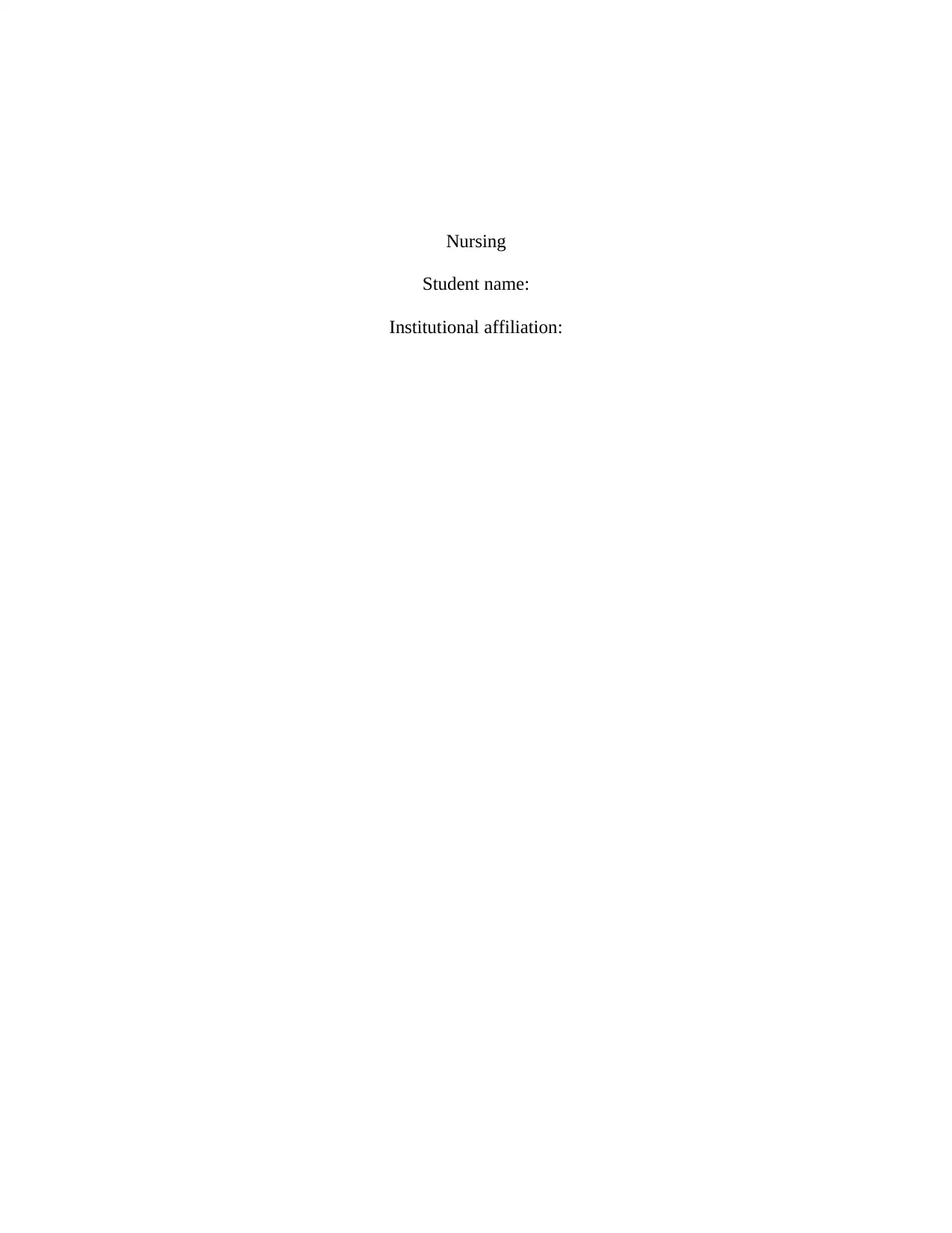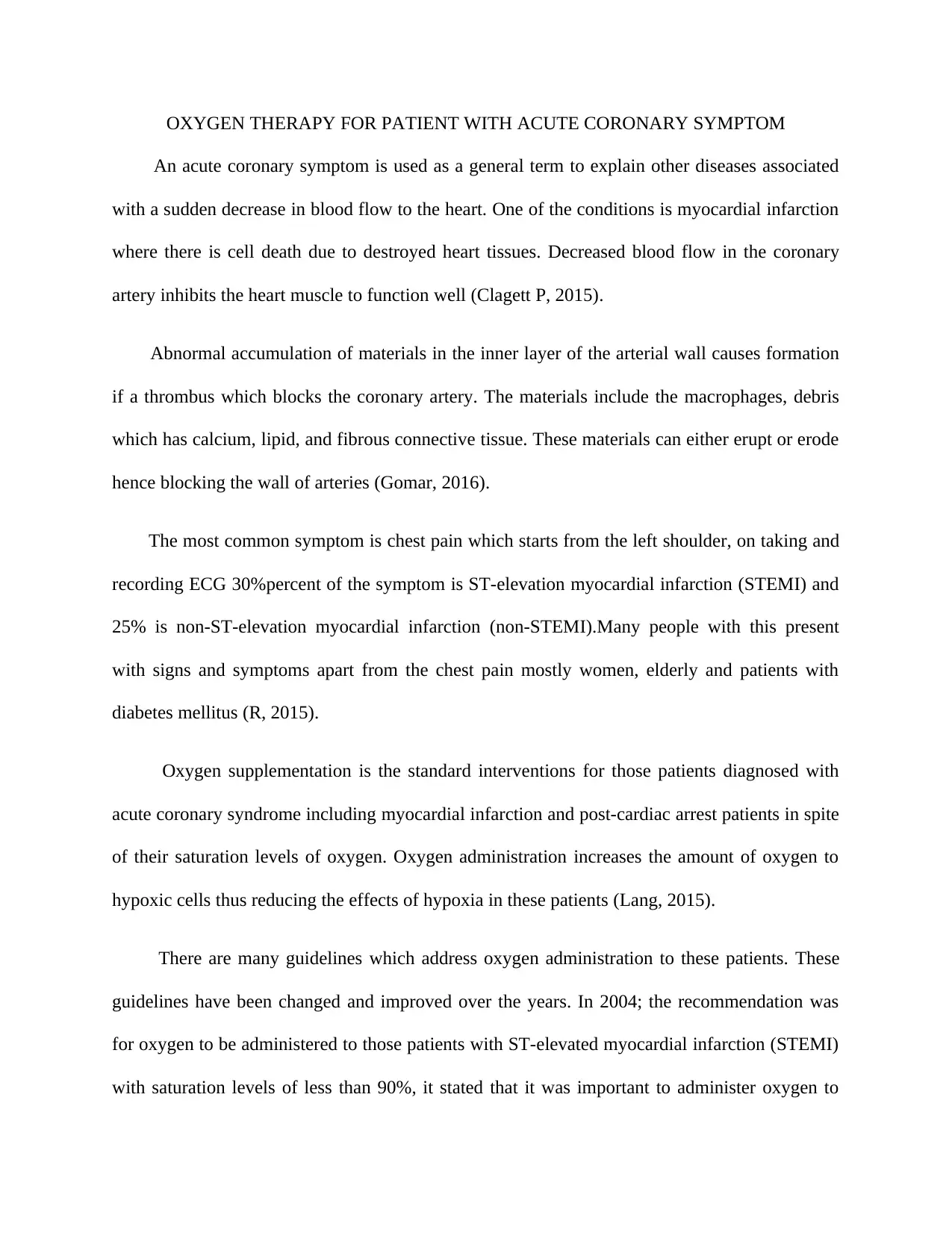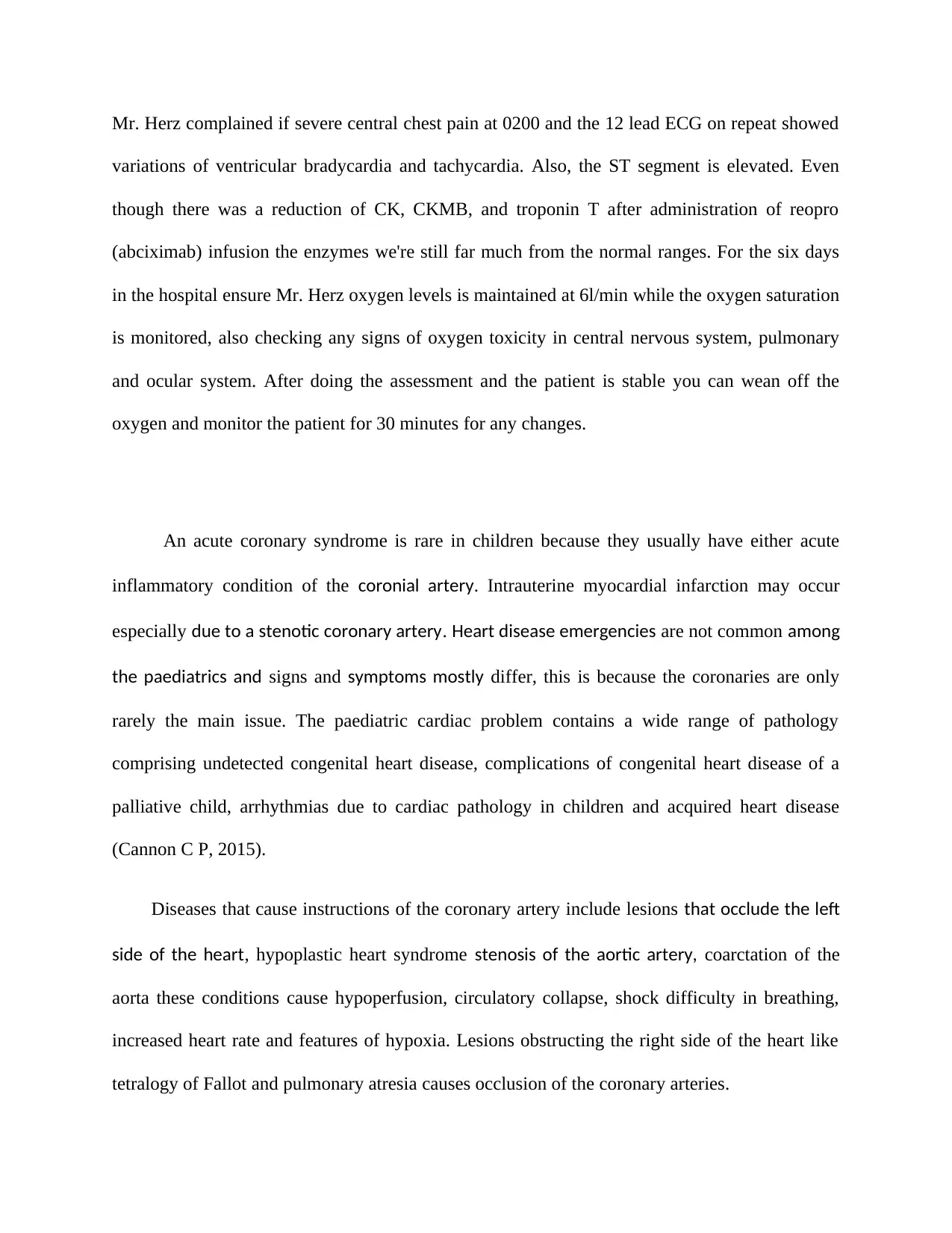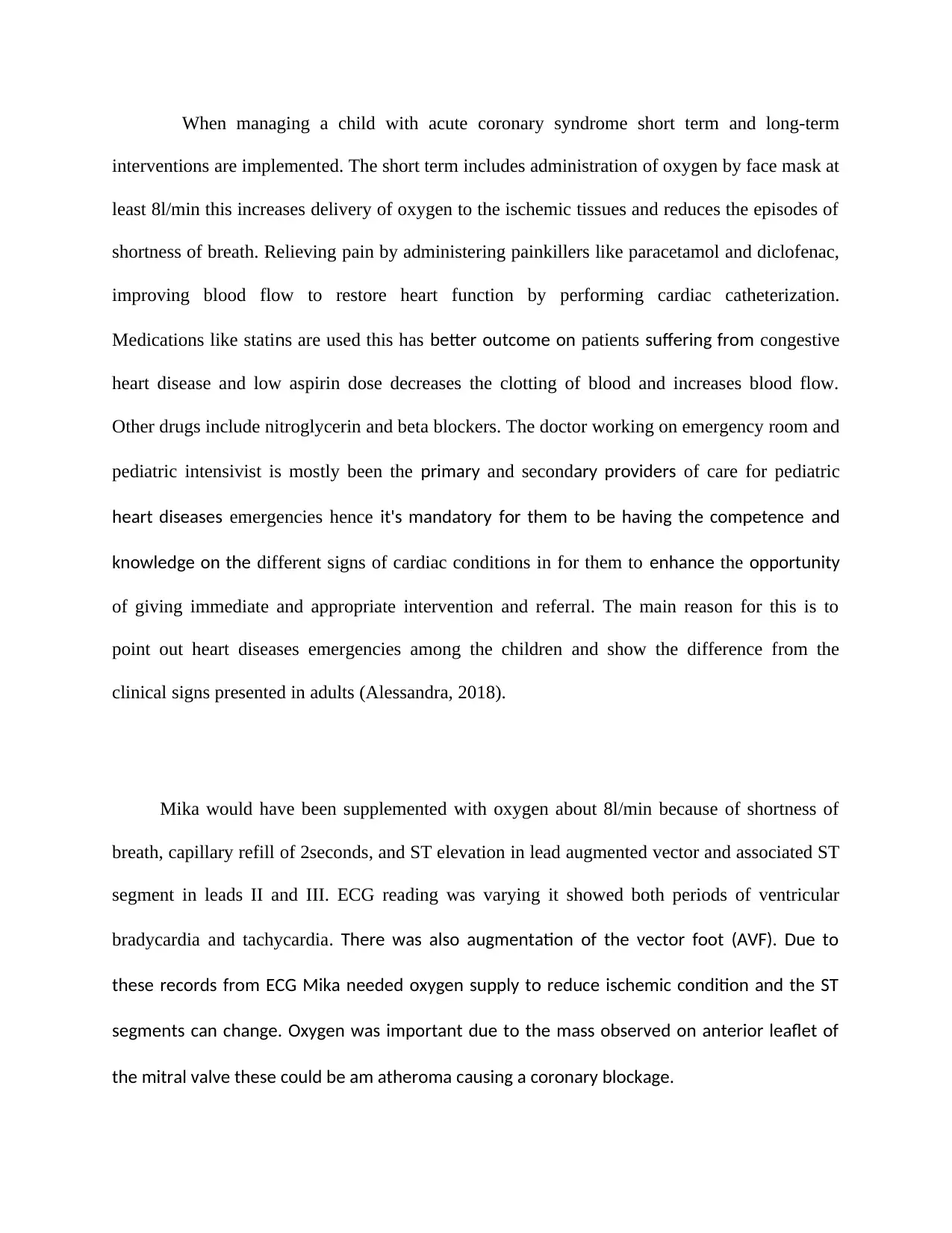Acute Coronary Syndrome: Oxygen Therapy in Adult and Pediatric Cases
VerifiedAdded on 2022/11/24
|9
|2235
|410
Case Study
AI Summary
This assignment is a case study analysis of oxygen therapy in acute coronary syndrome (ACS), focusing on two patients: Mr. Herz, an adult, and Mika, a pediatric patient. The paper explores the published evidence regarding oxygen therapy for compromised myocardium, including the guidelines and recommendations for oxygen administration in ACS, myocardial infarction, and post-cardiac arrest scenarios. The analysis considers the impact of oxygen saturation levels, the potential for oxygen toxicity, and the results of clinical trials like the AVOID and DETOX2X-MI studies. The assignment assesses the management of Mr. Herz and Mika, evaluating whether the reported oxygen administration therapy aligns with current guidelines, considering their presenting symptoms, ECG readings, and medical histories. The discussion includes the differences in managing ACS in adults versus children, highlighting the importance of early recognition and appropriate intervention. The paper is supported by references to peer-reviewed articles and guidelines from organizations such as the American Heart Association and the European Resuscitation Council. The cases are used to discuss the rationale for oxygen therapy, considering the patient's symptoms, and the evidence for oxygen administration, including the potential risks associated with hyperoxia, and the importance of maintaining oxygen saturation levels.

Nursing
Student name:
Institutional affiliation:
Student name:
Institutional affiliation:
Paraphrase This Document
Need a fresh take? Get an instant paraphrase of this document with our AI Paraphraser

OXYGEN THERAPY FOR PATIENT WITH ACUTE CORONARY SYMPTOM
An acute coronary symptom is used as a general term to explain other diseases associated
with a sudden decrease in blood flow to the heart. One of the conditions is myocardial infarction
where there is cell death due to destroyed heart tissues. Decreased blood flow in the coronary
artery inhibits the heart muscle to function well (Clagett P, 2015).
Abnormal accumulation of materials in the inner layer of the arterial wall causes formation
if a thrombus which blocks the coronary artery. The materials include the macrophages, debris
which has calcium, lipid, and fibrous connective tissue. These materials can either erupt or erode
hence blocking the wall of arteries (Gomar, 2016).
The most common symptom is chest pain which starts from the left shoulder, on taking and
recording ECG 30%percent of the symptom is ST-elevation myocardial infarction (STEMI) and
25% is non-ST-elevation myocardial infarction (non-STEMI).Many people with this present
with signs and symptoms apart from the chest pain mostly women, elderly and patients with
diabetes mellitus (R, 2015).
Oxygen supplementation is the standard interventions for those patients diagnosed with
acute coronary syndrome including myocardial infarction and post-cardiac arrest patients in spite
of their saturation levels of oxygen. Oxygen administration increases the amount of oxygen to
hypoxic cells thus reducing the effects of hypoxia in these patients (Lang, 2015).
There are many guidelines which address oxygen administration to these patients. These
guidelines have been changed and improved over the years. In 2004; the recommendation was
for oxygen to be administered to those patients with ST-elevated myocardial infarction (STEMI)
with saturation levels of less than 90%, it stated that it was important to administer oxygen to
An acute coronary symptom is used as a general term to explain other diseases associated
with a sudden decrease in blood flow to the heart. One of the conditions is myocardial infarction
where there is cell death due to destroyed heart tissues. Decreased blood flow in the coronary
artery inhibits the heart muscle to function well (Clagett P, 2015).
Abnormal accumulation of materials in the inner layer of the arterial wall causes formation
if a thrombus which blocks the coronary artery. The materials include the macrophages, debris
which has calcium, lipid, and fibrous connective tissue. These materials can either erupt or erode
hence blocking the wall of arteries (Gomar, 2016).
The most common symptom is chest pain which starts from the left shoulder, on taking and
recording ECG 30%percent of the symptom is ST-elevation myocardial infarction (STEMI) and
25% is non-ST-elevation myocardial infarction (non-STEMI).Many people with this present
with signs and symptoms apart from the chest pain mostly women, elderly and patients with
diabetes mellitus (R, 2015).
Oxygen supplementation is the standard interventions for those patients diagnosed with
acute coronary syndrome including myocardial infarction and post-cardiac arrest patients in spite
of their saturation levels of oxygen. Oxygen administration increases the amount of oxygen to
hypoxic cells thus reducing the effects of hypoxia in these patients (Lang, 2015).
There are many guidelines which address oxygen administration to these patients. These
guidelines have been changed and improved over the years. In 2004; the recommendation was
for oxygen to be administered to those patients with ST-elevated myocardial infarction (STEMI)
with saturation levels of less than 90%, it stated that it was important to administer oxygen to

these patients during the first six hours but unfortunately there was no information on the amount
of oxygen to be administered (Salamanca, 2017).
In 2014 American Heart Association on Acute Cardiac syndrome the guideline for taking
care of patients with Non-ST elevated myocardial infarction (non-STEMI) gave
recommendations of administering supplemental oxygen only to the patient with saturation
levels of less than 90%. Those also with respiratory distress or increased risk of developing
symptoms of hypoxemia (Helin, 2018).
In 2015 American Heart Association guideline update for Cardiopulmonary and
Resuscitation and Emergency Cardiovascular care at least gave more and specific directions on
oxygen therapy. Its review of the system noted observation studies which suggested that excess
oxygen in arteries concentrations hyperopia defined at a partial pressure of oxygen being more
than 300mmHg may adversely affect different organs or worsen its outcomes. These outcomes
oxygen toxicity is divided into central nervous system toxicity and the cardinal signs are the
presence of generalized tonic-clonic seizure, there is pulmonary and ocular toxicity whose signs
and symptoms include; disorientation, myopia, irritation of trachea leading to persistent
(Alessandra, 2018)
Cough, tightness of the chest causing dyspnea and difficulty in breathing. It was also noted
that other studies never managed to confirm these findings. These guidelines defined a hypoxic
state as oxygen saturation levels of less than 94% and it commented that it is very important to
prevent the episodes of hypoxia than to avoid any risk that can be caused by hypoxia (Hyun,
2017).
of oxygen to be administered (Salamanca, 2017).
In 2014 American Heart Association on Acute Cardiac syndrome the guideline for taking
care of patients with Non-ST elevated myocardial infarction (non-STEMI) gave
recommendations of administering supplemental oxygen only to the patient with saturation
levels of less than 90%. Those also with respiratory distress or increased risk of developing
symptoms of hypoxemia (Helin, 2018).
In 2015 American Heart Association guideline update for Cardiopulmonary and
Resuscitation and Emergency Cardiovascular care at least gave more and specific directions on
oxygen therapy. Its review of the system noted observation studies which suggested that excess
oxygen in arteries concentrations hyperopia defined at a partial pressure of oxygen being more
than 300mmHg may adversely affect different organs or worsen its outcomes. These outcomes
oxygen toxicity is divided into central nervous system toxicity and the cardinal signs are the
presence of generalized tonic-clonic seizure, there is pulmonary and ocular toxicity whose signs
and symptoms include; disorientation, myopia, irritation of trachea leading to persistent
(Alessandra, 2018)
Cough, tightness of the chest causing dyspnea and difficulty in breathing. It was also noted
that other studies never managed to confirm these findings. These guidelines defined a hypoxic
state as oxygen saturation levels of less than 94% and it commented that it is very important to
prevent the episodes of hypoxia than to avoid any risk that can be caused by hypoxia (Hyun,
2017).
⊘ This is a preview!⊘
Do you want full access?
Subscribe today to unlock all pages.

Trusted by 1+ million students worldwide

The basis of recommendation was to utilize the highest oxygen concerned which was
available up to the time the partial pressure of oxygen and saturation of oxyhemoglobin
saturation can be quantified. The guideline also indicated that it is more important and
knowledgeable to reduce FiO2 so long as it can be maintained at a rate if more than 94%.
The most known data concerning the use of oxygen is provided by Air Versus Oxygen
Myocardial Infarction (AVOID) trial. They used a random controlled method of study which
differentiated the outcomes of the supplementing oxygen 8l/min and those with no oxygen
supplements in those with ST-elevated Myocardial Infarction (STEMI)and oxygen saturation of
less or equal to 94% was taken using a pulse oximeter. The first result was measured by the use
of troponin and cardiac enzyme assays while the second outcomes were relapsing myocardial
infarction and cardiac arrhythmias. On monitoring, it was noted that statistics we're favoring a no
oxygen strategy (Salamanca, 2017).
In 2017 the Determination of the Role of Oxygen in Suspected Acute Myocardial Infarction
(DETOX2X-MI) clinical study registered acute coronary syndrome patient who had oxygen
saturation level of more than or equal to 90% to be administered with oxygen supplement and
those who inhaled air. There was insignificant statistical variation in that whole year because
there was a risk of death among the groups (Helin, 2018).
Mr. Herz
Maintain the oxygen levels of 6l/ min because the signs and symptoms are not improving,
during triage at accidents and emergency department the respiration rate was 26 breaths per
minute this indicated difficulty or pain during breathing, and the chest pain had persisted for
40minutes. The capillary refill was 2 seconds which was not normal. Even after the intervention,
available up to the time the partial pressure of oxygen and saturation of oxyhemoglobin
saturation can be quantified. The guideline also indicated that it is more important and
knowledgeable to reduce FiO2 so long as it can be maintained at a rate if more than 94%.
The most known data concerning the use of oxygen is provided by Air Versus Oxygen
Myocardial Infarction (AVOID) trial. They used a random controlled method of study which
differentiated the outcomes of the supplementing oxygen 8l/min and those with no oxygen
supplements in those with ST-elevated Myocardial Infarction (STEMI)and oxygen saturation of
less or equal to 94% was taken using a pulse oximeter. The first result was measured by the use
of troponin and cardiac enzyme assays while the second outcomes were relapsing myocardial
infarction and cardiac arrhythmias. On monitoring, it was noted that statistics we're favoring a no
oxygen strategy (Salamanca, 2017).
In 2017 the Determination of the Role of Oxygen in Suspected Acute Myocardial Infarction
(DETOX2X-MI) clinical study registered acute coronary syndrome patient who had oxygen
saturation level of more than or equal to 90% to be administered with oxygen supplement and
those who inhaled air. There was insignificant statistical variation in that whole year because
there was a risk of death among the groups (Helin, 2018).
Mr. Herz
Maintain the oxygen levels of 6l/ min because the signs and symptoms are not improving,
during triage at accidents and emergency department the respiration rate was 26 breaths per
minute this indicated difficulty or pain during breathing, and the chest pain had persisted for
40minutes. The capillary refill was 2 seconds which was not normal. Even after the intervention,
Paraphrase This Document
Need a fresh take? Get an instant paraphrase of this document with our AI Paraphraser

Mr. Herz complained if severe central chest pain at 0200 and the 12 lead ECG on repeat showed
variations of ventricular bradycardia and tachycardia. Also, the ST segment is elevated. Even
though there was a reduction of CK, CKMB, and troponin T after administration of reopro
(abciximab) infusion the enzymes we're still far much from the normal ranges. For the six days
in the hospital ensure Mr. Herz oxygen levels is maintained at 6l/min while the oxygen saturation
is monitored, also checking any signs of oxygen toxicity in central nervous system, pulmonary
and ocular system. After doing the assessment and the patient is stable you can wean off the
oxygen and monitor the patient for 30 minutes for any changes.
An acute coronary syndrome is rare in children because they usually have either acute
inflammatory condition of the coronial artery. Intrauterine myocardial infarction may occur
especially due to a stenotic coronary artery. Heart disease emergencies are not common among
the paediatrics and signs and symptoms mostly differ, this is because the coronaries are only
rarely the main issue. The paediatric cardiac problem contains a wide range of pathology
comprising undetected congenital heart disease, complications of congenital heart disease of a
palliative child, arrhythmias due to cardiac pathology in children and acquired heart disease
(Cannon C P, 2015).
Diseases that cause instructions of the coronary artery include lesions that occlude the left
side of the heart, hypoplastic heart syndrome stenosis of the aortic artery, coarctation of the
aorta these conditions cause hypoperfusion, circulatory collapse, shock difficulty in breathing,
increased heart rate and features of hypoxia. Lesions obstructing the right side of the heart like
tetralogy of Fallot and pulmonary atresia causes occlusion of the coronary arteries.
variations of ventricular bradycardia and tachycardia. Also, the ST segment is elevated. Even
though there was a reduction of CK, CKMB, and troponin T after administration of reopro
(abciximab) infusion the enzymes we're still far much from the normal ranges. For the six days
in the hospital ensure Mr. Herz oxygen levels is maintained at 6l/min while the oxygen saturation
is monitored, also checking any signs of oxygen toxicity in central nervous system, pulmonary
and ocular system. After doing the assessment and the patient is stable you can wean off the
oxygen and monitor the patient for 30 minutes for any changes.
An acute coronary syndrome is rare in children because they usually have either acute
inflammatory condition of the coronial artery. Intrauterine myocardial infarction may occur
especially due to a stenotic coronary artery. Heart disease emergencies are not common among
the paediatrics and signs and symptoms mostly differ, this is because the coronaries are only
rarely the main issue. The paediatric cardiac problem contains a wide range of pathology
comprising undetected congenital heart disease, complications of congenital heart disease of a
palliative child, arrhythmias due to cardiac pathology in children and acquired heart disease
(Cannon C P, 2015).
Diseases that cause instructions of the coronary artery include lesions that occlude the left
side of the heart, hypoplastic heart syndrome stenosis of the aortic artery, coarctation of the
aorta these conditions cause hypoperfusion, circulatory collapse, shock difficulty in breathing,
increased heart rate and features of hypoxia. Lesions obstructing the right side of the heart like
tetralogy of Fallot and pulmonary atresia causes occlusion of the coronary arteries.

When managing a child with acute coronary syndrome short term and long-term
interventions are implemented. The short term includes administration of oxygen by face mask at
least 8l/min this increases delivery of oxygen to the ischemic tissues and reduces the episodes of
shortness of breath. Relieving pain by administering painkillers like paracetamol and diclofenac,
improving blood flow to restore heart function by performing cardiac catheterization.
Medications like statins are used this has better outcome on patients suffering from congestive
heart disease and low aspirin dose decreases the clotting of blood and increases blood flow.
Other drugs include nitroglycerin and beta blockers. The doctor working on emergency room and
pediatric intensivist is mostly been the primary and secondary providers of care for pediatric
heart diseases emergencies hence it's mandatory for them to be having the competence and
knowledge on the different signs of cardiac conditions in for them to enhance the opportunity
of giving immediate and appropriate intervention and referral. The main reason for this is to
point out heart diseases emergencies among the children and show the difference from the
clinical signs presented in adults (Alessandra, 2018).
Mika would have been supplemented with oxygen about 8l/min because of shortness of
breath, capillary refill of 2seconds, and ST elevation in lead augmented vector and associated ST
segment in leads II and III. ECG reading was varying it showed both periods of ventricular
bradycardia and tachycardia. There was also augmentation of the vector foot (AVF). Due to
these records from ECG Mika needed oxygen supply to reduce ischemic condition and the ST
segments can change. Oxygen was important due to the mass observed on anterior leaflet of
the mitral valve these could be am atheroma causing a coronary blockage.
interventions are implemented. The short term includes administration of oxygen by face mask at
least 8l/min this increases delivery of oxygen to the ischemic tissues and reduces the episodes of
shortness of breath. Relieving pain by administering painkillers like paracetamol and diclofenac,
improving blood flow to restore heart function by performing cardiac catheterization.
Medications like statins are used this has better outcome on patients suffering from congestive
heart disease and low aspirin dose decreases the clotting of blood and increases blood flow.
Other drugs include nitroglycerin and beta blockers. The doctor working on emergency room and
pediatric intensivist is mostly been the primary and secondary providers of care for pediatric
heart diseases emergencies hence it's mandatory for them to be having the competence and
knowledge on the different signs of cardiac conditions in for them to enhance the opportunity
of giving immediate and appropriate intervention and referral. The main reason for this is to
point out heart diseases emergencies among the children and show the difference from the
clinical signs presented in adults (Alessandra, 2018).
Mika would have been supplemented with oxygen about 8l/min because of shortness of
breath, capillary refill of 2seconds, and ST elevation in lead augmented vector and associated ST
segment in leads II and III. ECG reading was varying it showed both periods of ventricular
bradycardia and tachycardia. There was also augmentation of the vector foot (AVF). Due to
these records from ECG Mika needed oxygen supply to reduce ischemic condition and the ST
segments can change. Oxygen was important due to the mass observed on anterior leaflet of
the mitral valve these could be am atheroma causing a coronary blockage.
⊘ This is a preview!⊘
Do you want full access?
Subscribe today to unlock all pages.

Trusted by 1+ million students worldwide

References
Berny‐Lang, M. A., Darling, C. E., Frelinger III, A. L., Barnard, M. R., Smith, C. S., &
Michelson, A. D. (2015). Do immature platelet levels in chest pain patients presenting to the
emergency department aid in the diagnosis of acute coronary syndrome?. International journal of
laboratory hematology, 37(1), 112-119
Callaway, C. W., Soar, J., Aibiki, M., Böttiger, B. W., Brooks, S. C., Deakin, C. D., ... & Morrison, L.
J. (2015). Part 4: advanced life support: 2015 international consensus on cardiopulmonary
resuscitation and emergency cardiovascular care science with treatment recommendations.
Circulation, 132(16_suppl_1), S84-S145.
Cannon, C. P., Blazing, M. A., Giugliano, R. P., McCagg, A., White, J. A., Theroux, P., ... & De
Ferrari, G. M. (2015). Ezetimibe added to statin therapy after acute coronary syndromes. New
England Journal of Medicine, 372(25), 2387-2397.
Miguel, J. A., Lechuga, Y., Allende, M. A., & Martinez, M. (2017, November). CCO-based analog
front-end for iStents. In 2017 32nd Conference on Design of Circuits and Integrated Systems
(DCIS) (pp. 1-6). IEEE.
Monsieurs, K. G., Nolan, J. P., Bossaert, L. L., Greif, R., Maconochie, I. K., Nikolaou, N. I., ... &
Zideman, D. A. (2015). European resuscitation council guidelines for resuscitation 2015 section
1. Executive summary. Resuscitation.-Limerick, 1972, currens, 95, 1-80.
Berny‐Lang, M. A., Darling, C. E., Frelinger III, A. L., Barnard, M. R., Smith, C. S., &
Michelson, A. D. (2015). Do immature platelet levels in chest pain patients presenting to the
emergency department aid in the diagnosis of acute coronary syndrome?. International journal of
laboratory hematology, 37(1), 112-119
Callaway, C. W., Soar, J., Aibiki, M., Böttiger, B. W., Brooks, S. C., Deakin, C. D., ... & Morrison, L.
J. (2015). Part 4: advanced life support: 2015 international consensus on cardiopulmonary
resuscitation and emergency cardiovascular care science with treatment recommendations.
Circulation, 132(16_suppl_1), S84-S145.
Cannon, C. P., Blazing, M. A., Giugliano, R. P., McCagg, A., White, J. A., Theroux, P., ... & De
Ferrari, G. M. (2015). Ezetimibe added to statin therapy after acute coronary syndromes. New
England Journal of Medicine, 372(25), 2387-2397.
Miguel, J. A., Lechuga, Y., Allende, M. A., & Martinez, M. (2017, November). CCO-based analog
front-end for iStents. In 2017 32nd Conference on Design of Circuits and Integrated Systems
(DCIS) (pp. 1-6). IEEE.
Monsieurs, K. G., Nolan, J. P., Bossaert, L. L., Greif, R., Maconochie, I. K., Nikolaou, N. I., ... &
Zideman, D. A. (2015). European resuscitation council guidelines for resuscitation 2015 section
1. Executive summary. Resuscitation.-Limerick, 1972, currens, 95, 1-80.
Paraphrase This Document
Need a fresh take? Get an instant paraphrase of this document with our AI Paraphraser

Pelletier, R., Ditto, B., & Pilote, L. (2015). A composite measure of gender and its association
with risk factors in patients with the premature acute coronary syndrome. Psychosomatic
Medicine, 77(5), 517-526.
Pelletier, R., Khan, N. A., Cox, J., Daskalopoulou, S. S., Eisenberg, M. J., Bacon, S. L., ... &
Norris, C. M. (2016). Sex versus gender-related characteristics: which predicts outcome after
acute coronary syndrome in the young?. Journal of the American College of Cardiology, 67(2),
127-135.
Pfeffer, M. A., Claggett, B., Diaz, R., Dickstein, K., Gerstein, H. C., Køber, L. V., ... &
Maggioni, A. P. (2015). Lixisenatide in patients with type 2 diabetes and acute coronary
syndrome. New England Journal of Medicine, 373(23), 2247-2257.
Sabouhi, F., Maleki, M., Amini, M., & Kerdegari, M. (2015). Impacts of insulin infusion
protocol on blood glucose level and outcomes in acute coronary syndrome patients with diabetes
mellitus. Iranian journal of nursing and midwifery research, 20(3), 304.
Sanchis-Gomar, F., Perez-Quilis, C., Leischik, R., & Lucia, A. (2016). Epidemiology of
coronary heart disease and acute coronary syndrome. Annals of translational medicine, 4(13).
Sarrato, G. Z., García, E. S., Maldonado, J. A., Robles, C. G., Lluch, M. T., Sanz, M. I., & Grupo
de Reanimación Neonatal de la Sociedad Española de Neonatología. (2017). Changes in the
international recommendations on neonatal stabilisation and resuscitation (2015). Anales de
Pediatría (English Edition), 86(1), 51-e1.
Thompson, P. L. (2011). Coronary care manual. Elsevier Health Sciences.
with risk factors in patients with the premature acute coronary syndrome. Psychosomatic
Medicine, 77(5), 517-526.
Pelletier, R., Khan, N. A., Cox, J., Daskalopoulou, S. S., Eisenberg, M. J., Bacon, S. L., ... &
Norris, C. M. (2016). Sex versus gender-related characteristics: which predicts outcome after
acute coronary syndrome in the young?. Journal of the American College of Cardiology, 67(2),
127-135.
Pfeffer, M. A., Claggett, B., Diaz, R., Dickstein, K., Gerstein, H. C., Køber, L. V., ... &
Maggioni, A. P. (2015). Lixisenatide in patients with type 2 diabetes and acute coronary
syndrome. New England Journal of Medicine, 373(23), 2247-2257.
Sabouhi, F., Maleki, M., Amini, M., & Kerdegari, M. (2015). Impacts of insulin infusion
protocol on blood glucose level and outcomes in acute coronary syndrome patients with diabetes
mellitus. Iranian journal of nursing and midwifery research, 20(3), 304.
Sanchis-Gomar, F., Perez-Quilis, C., Leischik, R., & Lucia, A. (2016). Epidemiology of
coronary heart disease and acute coronary syndrome. Annals of translational medicine, 4(13).
Sarrato, G. Z., García, E. S., Maldonado, J. A., Robles, C. G., Lluch, M. T., Sanz, M. I., & Grupo
de Reanimación Neonatal de la Sociedad Española de Neonatología. (2017). Changes in the
international recommendations on neonatal stabilisation and resuscitation (2015). Anales de
Pediatría (English Edition), 86(1), 51-e1.
Thompson, P. L. (2011). Coronary care manual. Elsevier Health Sciences.

⊘ This is a preview!⊘
Do you want full access?
Subscribe today to unlock all pages.

Trusted by 1+ million students worldwide
1 out of 9
Related Documents
Your All-in-One AI-Powered Toolkit for Academic Success.
+13062052269
info@desklib.com
Available 24*7 on WhatsApp / Email
![[object Object]](/_next/static/media/star-bottom.7253800d.svg)
Unlock your academic potential
Copyright © 2020–2025 A2Z Services. All Rights Reserved. Developed and managed by ZUCOL.





